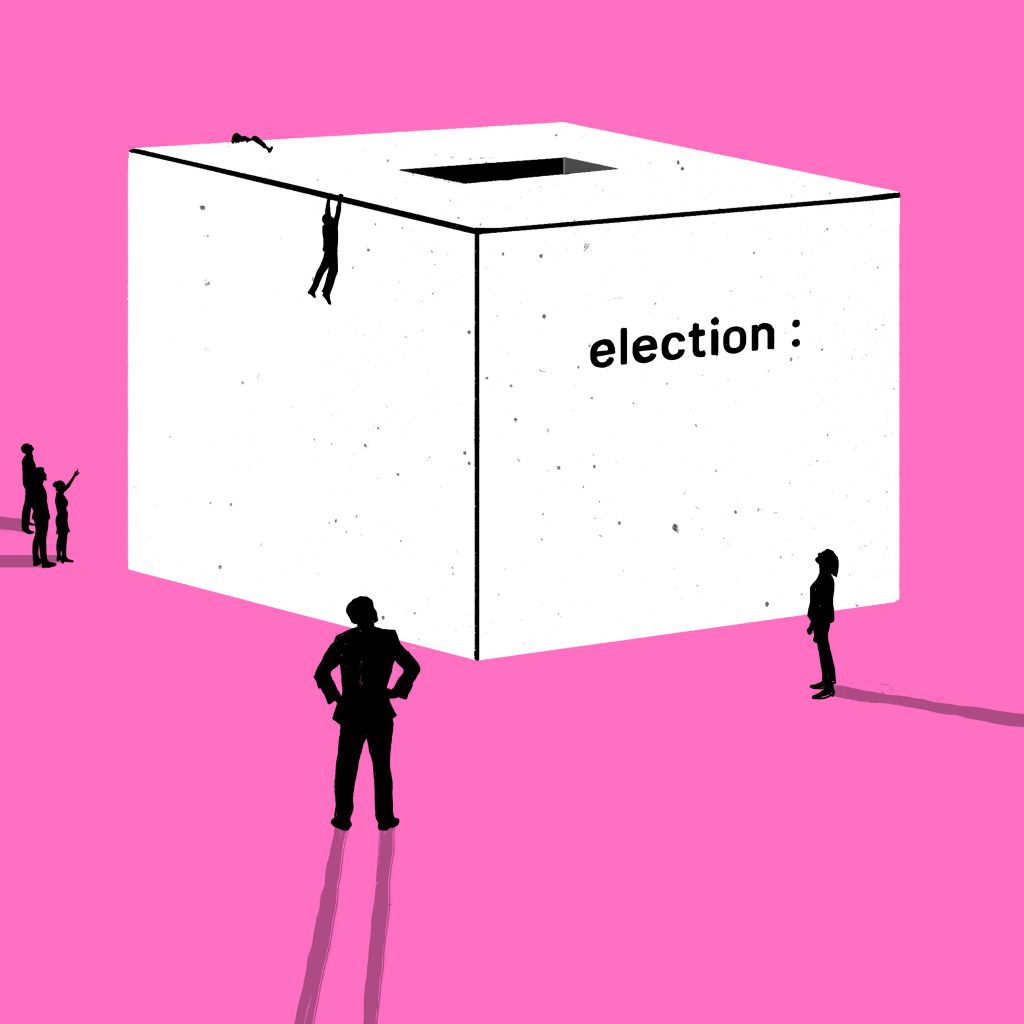
Kenya was established as a republic in December 1964 after gaining independence from British colonial rule, and Jomo Kenyatta was elected Kenya’s first president. In 1969, Kenyatta transformed the new nation into a one-party state, leaving the Kenya African National Union (KANU) as the sole party that won all parliamentary seats through 1997. Kenyatta died in office in 1978, and Daniel arap Moi—then vice president—continued the presidency, becoming the country’s second president.
When fierce democratic pluralism swept across Africa in the late 1980s, Moi restored multiparty politics in 1992. Amid an outcry of election rigging, he won that year’s elections, as well as the 1997 election. In 2002, he declared that he would retire from the presidency and groomed Uhuru Kenyatta, the son of Jomo Kenyatta, to lead KANU and take over the presidency. However, Uhuru Kenyatta was to face fierce competition from Mwai Kibaki, who campaigned on the National Rainbow Coalition (NARC) party—a coalition of several small parties—promising new constitutional reforms and an end to government corruption. The outline below details the events that led to a new constitution and a new era of democracy in Kenya.
3 December 2002 : Mwai Kibaki is involved in a near-fatal car accident while heading to Nairobi after holding campaign rallies in the eastern region. He is flown to London where he seeks treatment for two weeks before returning to continue his presidential campaign.
27 December 2002 : Elections are held. Kibaki wins a landslide victory, ending Daniel arap Moi’s 24-year rule and KANU’s four decades in power.
29 December 2002 : Kibaki is sworn in as the third president of Kenya. At the inauguration, he stresses his opposition to government corruption, promising that “government will no longer be run on the whims of individuals.”
February 2003 : Kibaki convenes a group of delegates to oversee the drafting of a new constitution. Through public hearings and memoranda, public views are collected, after which the delegates begin debate and ratification of the draft.
15 March 2004 : A proposed new constitution known as the Bomas draft is released. This draft proposes wide-reaching changes to the structure of government, land reform, religious courts, and presidential power, including the sharing of power between the president and a newly created post of prime minister.
August 2004 : Fearing the loss of power, senior government officials—most of whom had been governing since Moi’s era—amend the Bomas draft. The new amendments provide for an executive president and a nominal prime minister appointed by the former. These amendments lead to widespread opposition, civil unrest, and the resignation of several senior members of Kibaki’s coalition.
January 2005 : Kibaki starts a nationwide campaign for the amended Bomas draft constitution. The draft is distributed to everyone in the country to read. The opposition is skeptical of the amendments made to the Bomas draft and see them as a ploy by Kibaki to exert dictatorial authority since the amendments disproportionately vest power to the president. Further, because Kibaki so vigorously promoted the new constitution and based his election campaign around it, many voters will use the approaching referendum merely as a means to voice their approval or disapproval of the Kibaki government.
21 November 2005 : Kenya holds its first-ever national referendum on a proposed constitution. Voters take to the ballot. After a contentious review process, 58% of voters reject the proposed new constitution in what is seen as a protest against President Kibaki.
23 November 2005 : Following the rejection of the draft constitution, Kibaki dismisses his entire cabinet and deputy ministers, stating that he needs to reorganize his government to make it more cohesive and better able to serve Kenyans. Kenyans and the opposition overwhelmingly approve of Kibaki’s decision, since the government had been embroiled in corruption exposés for a long time and the decision to dismiss the cabinet was seen as long overdue.
27 November 2005 : The opposition, the Orange Democratic Movement (ODM) led by Raila Odinga, calls for nationwide demonstrations to pressure the government for new elections since Kibaki has failed to deliver on his campaign promises—i.e., to end corruption and introduce a new constitution. Kibaki outlaws all demonstrations in support of new elections.
7 December 2005 : Kibaki announces his new appointments for his cabinet and minister positions. A large portion of the appointees turn down the job offers, citing Kibaki’s failure to consult with all parties in the coalition regarding the make-up of the new cabinet.
9 December 2005 : Kibaki swears in the new cabinet, comprised mostly of his closest political allies.
26 January 2007 : Kibaki states his intention to run for re-election under a new political party, the Party of National Unity (PNU), a coalition of smaller parties that supports his re-election. His main opponent, Raila Odinga, runs for election with the Orange Democratic Movement (ODM). At this time, opinion polls show support for Odinga at 17%, but by December 2007, he has 45% voter support as compared to Kibaki’s 43%.
27 December 2007 : National elections are held.
29 December 2007 : Vote tallies show Odinga in the lead, and the ODM party declares victory for Odinga. However, as more results are announced throughout the day, the gap between Kibaki and Odinga narrows. With almost 90% of the votes counted, Odinga’s lead shrinks to 38,000 votes.
30 December 2007 : The Electoral Commission announces Kibaki as the winner. Within minutes of the Commission’s declaration, Kibaki is sworn in in the night. Tribe-based rioting and violence—mostly directed at Kikuyus, Kibakis’s tribe—breaks out across Kenya. The government suspends live television coverage for several days.
1–5 January 2008 : The Electoral Commission chairman, Samuel Kivuitu, says that he had been pressured by the PNU and ODM leaders to announce results immediately, despite the urgings of foreign ambassadors to delay the results so that concerns about irregularities could be addressed. Widespread violence around the country continues. The attorney general calls for a recount and investigation into the election. Odinga asks for new elections. Kibaki dismisses the ongoing violence as a local problem that he will deal with amicably.
6 January 2008 : Upon Kibakis’ invitation, the African Union chairman John Kufuor arrives to help resolve the crisis. Kufuor meets separately with Kibaki and Odinga, whereby he suggests an interim coalition government and an inquiry into the Electoral Commission. Kibaki rejects this idea. However, Kibaki and Odinga ultimately agree to work with a panel of eminent African leaders—led by former UN Secretary General Kofi Annan—to resolve their differences. Kufuor leaves.
15–21 January : Supporters of Odinga hold nationwide rallies and boycott companies controlled by Kibaki’s allies. Working under Kibaki’s government orders, police kill at least 22 people.
22 January 2008 : Kofi Annan arrives in Nairobi to hold peace talks with Odinga and Kibaki. Annan meets with Odinga and convinces him to call off the rallies.
23 January–4 February : As the peace talks mediated by Annan continue, tribal violence escalates. It is reported that over 1,300 people have been killed and 600,000 displaced from their homes.
28 February 2008 : A peace deal resolution is reached to end the crisis. Kibaki and Odinga agree to form a coalition government, with Odinga set to receive the new position of prime minister, in which capacity he is to “coordinate and supervise government affairs.” The peace deal also calls for an urgent revision of the constitution.
April 2008 : The government and opposition set up a cabinet. The National Accord and Reconciliation Act is implemented, making Odinga the first prime minister in Kenya since 1964.
November 2009 : A new draft of the constitution is presented to parliament. The new constitution is designed to limit the powers of the president and devolve power to the regions approved of in the referendum. After minor modifications, the National Assembly and parliament approve the draft. Odinga and Kibaki support the new constitution.
4 August 2010 : A nationwide constitutional referendum is held, asking Kenyans whether they support or oppose the proposed new constitution. 68.6% of voters vote in approval of the proposed constitution.
27 August 2010 : The new constitution is formally promulgated by Kibaki.

